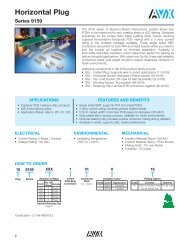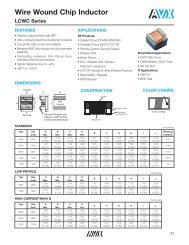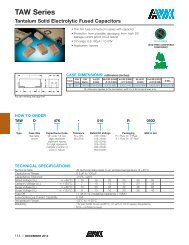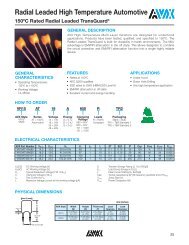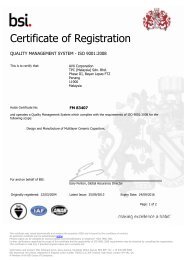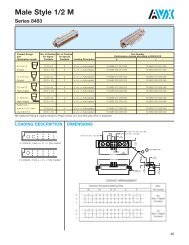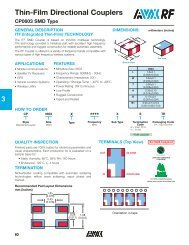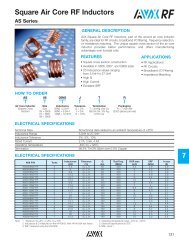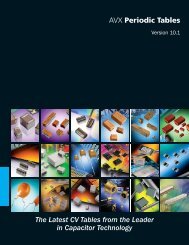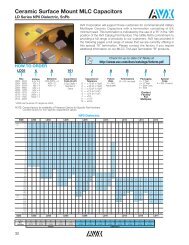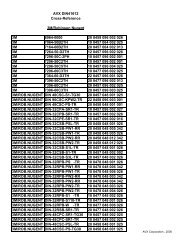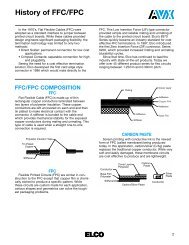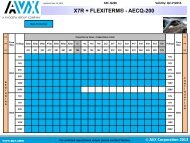TECHNICAL INFORMATION - AVX
TECHNICAL INFORMATION - AVX
TECHNICAL INFORMATION - AVX
Create successful ePaper yourself
Turn your PDF publications into a flip-book with our unique Google optimized e-Paper software.
I. Introduction<br />
FACTORS RESPONSIBLE FOR<br />
THERMAL SHOCK BEHAVIOR<br />
OF CHIP CAPACITORS<br />
The study of mechanical properties and thermal<br />
shock resistance parameters of multilayer ceramic<br />
capacitors (MLCs) is becoming increasingly important<br />
because of their increase in surface mount applications.<br />
A brief description of various aspects of this<br />
complex subject is given in the following paragraphs<br />
and some of the important factors are experimentally<br />
evaluated in this paper, a first in a series of papers to<br />
be devoted to this important subject. The obvious<br />
approach appears to be to consider the different<br />
sources of stresses possible in these devices, and then<br />
study the critical stress intensity factors and slow subcritical<br />
crack growth to obtain the critical stresses the<br />
devices can tolerate above which deleterious flaws<br />
result. This will allow us to study various aspects of<br />
the surface mount applications.<br />
A. Complexities of the MLC itself:<br />
As described earlier, 1 this monolithic device consists<br />
of barium titanate based dielectric ceramics<br />
with interleaved layers of palladium or palladiumsilver<br />
alloys, and a termination which consists of<br />
Pd/Ag alloys and/or a nickel barrier and a solder<br />
coating. This device is mounted on a substrate with<br />
or without epoxy and all these materials have a<br />
wide spectrum of thermal expansion coefficients<br />
and these are listed in Table 1. Residual stresses<br />
MATERIAL<br />
TABLE 1<br />
CTEs (ppm/°C)<br />
Barium Titanate Based Ceramics 9.5-11.5<br />
Pd/Ag Alloys 13-17<br />
Tin Lead Alloys 27<br />
Nickel 13-14<br />
Copper 17.6<br />
Alumina 7<br />
FR-4/G-10 PCB<br />
(in x-y directions only)<br />
18<br />
Polyimide Glass PCB<br />
(in x-y directions only)<br />
12<br />
Polyimide Kevlar PCB<br />
(in x-y directions only)<br />
7<br />
Epoxy Adhesives 20-100<br />
and other mechanical properties like elastic modulus<br />
and hardness have been studied 2 on polished<br />
sections of MLCs utilizing fracture mechanics<br />
By Bharat S. Rawal,<br />
Richard Ladew and<br />
Ricardo Garcia<br />
analysis based on the propagation of mutually perpendicular<br />
penny-like median/radial cracks using<br />
the Vicker’s micro-indentation techniques, and by<br />
indentation-biaxial fracture techniques for inert<br />
strength measurements. 3,4 These residual stresses<br />
by themselves are expected 2 to make only a small<br />
contribution to the overall stress state in these<br />
devices compared to the thermal stresses.<br />
B. Thermal Stresses<br />
When ceramics are subjected to a rapid change<br />
in temperature (such as plunging MLCs in a solder<br />
bath) stresses result because the surface reaches the<br />
new temperature instantly and the interior either<br />
remains at the initial temperature or, in most practical<br />
cases, there is a temperature gradient. For<br />
various geometries with parabolic temperature<br />
distributions where the average temperature is<br />
intermediate between the surface and center<br />
temperature, the corresponding stress s is found to<br />
be such that<br />
s ∆T (1)<br />
where ∆T is the temperature difference between<br />
the surface and center of a sample. This may be<br />
rewritten as<br />
s = E Søt 2 (2)<br />
(1-) (k/ C p )<br />
where E is the elastic modulus, is the coefficient<br />
of linear thermal expansion, s is the shape factor (s<br />
is 0.33 for a plate and 0.221 for a cube), ø is the rate<br />
of change of temperature, t is, for example, the half<br />
thickness for a plate, is Poisson’s ratio and (k/ C p )<br />
is the thermal diffusivity with k, and C p being the<br />
thermal conductivity, density and specific heat<br />
respectively. It is realized that for an MLC we are<br />
really dealing with a composite of metal-ceramic<br />
layers, and anisotropy of various parameters listed<br />
in equation (2) is expected; these aspects will be discussed<br />
in a later paper. 6 As equation (2) suggests<br />
and as a number of analytical studies have shown. 7-9<br />
materials with low E, low and low along with<br />
high thermal diffusivity are desirable. Equation (2)<br />
and these studies also clearly demonstrate that,<br />
when comparing materials or processes, lower rates<br />
of change of temperature and especially thinner<br />
geometries (because of the square dependence on<br />
the thickness) are desirable.<br />
Aside from the thermal conductivity k, another<br />
parameter which must be considered in heat transfer<br />
studies and corresponding thermal stresses in<br />
materials, is the surface heat transfer coefficient, h.<br />
This parameter changes rapidly with the surface<br />
characteristics of materials and it increases with<br />
improving contact between the two media across<br />
which the heat transfer takes place. Because of a<br />
temperature gradient surface stresses result in the<br />
material and this stress is proportional to h/k.



